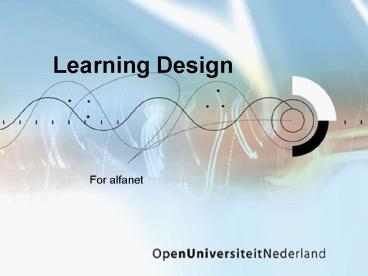Learning Design - PowerPoint PPT Presentation
1 / 34
Title:
Learning Design
Description:
Learning Design For alfanet An overview 9:00 Welcome 9:15 What is Learning Design all about? Short experience Analysis Forget about the levels Seeing is believing 12 ... – PowerPoint PPT presentation
Number of Views:32
Avg rating:3.0/5.0
Title: Learning Design
1
Learning Design
For alfanet
2
An overview
Today
- 900 Welcome
- 915 What is Learning Design all about?
- Short experience
- Analysis
- Forget about the levels
- Seeing is believing
- 1230 1300 Lunch
- 1300 Learning by doing
- Case introduction
- Course structure
- Translation into LD
- Tying it together
- 1700 Closing
3
An overview
Tomorrow
- 900 Welcome
- 915 Dynamics of Learning Design
- What are properties
- How can properties be used
- Example
- 1230 1300 Lunch
- 1300 Learning by doing
- Diving into the deep XML sea
- 1430 Looking back
- See the results of day 1
- 1500 Evaluation
- Patricia Leo
- 1700 Closing
4
What is Learning Design all about?
- A language to describe education
- Curriculum
- Course
- Lesson
- What is it not?
- Programming language
- A instructional method
- A guaranty for good education
- Flexible in its presentation
- Learner centred
5
Short experience
- We will simulate a short role play
- Designing a house
- Roles?
- Dependencies?
- Structure
6
Analysis
- Play
- Act
- Role-parts
- Activities (structure)
- Sequence
- Selection
- Environments
- Services
- Conference
- Monitor
- Play
- Properties
- conditions
7
Theatre metaphor
8
Forget about the levels
- The levels are only useful for technicians not
for educators - But still it helps a little
9
The basics Level AHave your ALFANET editor ready
- Three types of activities
- Learning activity
- Support activity
- Activity structure
- Two types of roles
- Learner
- Staff
- The environment
- Learning objects
- Services
10
Relation
- Learning activities
- A learner learns by doing activities
- Primarily for the learners
- Core of the education
- Activity structure
- Sometimes the activities need to be carried out
in a specified order or the learner may choose
what to do. - Environment
- To perform an activity some materials might be
needed - The learner needs to communicate with others
- Support activity
- Learner or staff with special activity to help
(other) learners.
11
The dynamics Level B
- Properties can determine how a learner progresses
through the course or what is made visible. - Activities
- Content within an activity
- Completion of activities, acts, play and unit of
learning can be made dependable on properties - Services are given extra possibilities
- Conditions can depend on Calculations with
properties
12
Communication Level C
- Notifications inform (someone in) a role that
something has happened - Depending on completion of
- Some activity
- Some condition with properties
13
Learning by Doing
- Go to components
- Go to Roles
14
Seeing is believing
Go to educontent.ou.nl Login with
ou-student1 Pw student
15
What did you see?
- Activities
- Single activities
- Activity structure
- Sequence
- Structures within structures (nesting)
- Environment
- Learning objects
- Nested environments
16
What more did you see?
- Properties
- Fill-in forms
Content control
17
And ?
- Properties
- Selection forms
Content Types
18
Learning by doing
- Now its your turn
- Take the course outline you are planning to
create - Add to that the environments (learning objects
and services) - Complete the course till level A
19
Your course
- Course structure
- Think of what who needs what at what moment
- (Environments)
- Do you already have the content?
- What content relates to what activity
20
Ready?
- Create a Package interchange File
- We send the package to Sage
- Tomorrow we can see them!
21
Diving into the deep
22
You wanted properties Here they come
- Properties come in threes
- In the Components
- In the Play
- In the content
23
In the components
- This is the place where the properties are
declared
24
Four types of properties
- Local properties
- Used within the unit of learning
- Same for every user in a run
- Different for another run
- Global properties
- Used outside a unit of learning
- Defined in one UOL and used in another one
- Personal properties
- Owned by a person
- Can be local or global
- Role properties
- Owned by a role
- Always local
25
Components in more detail
26
In the Play
27
Play in more detail
28
In the Content
29
Content in more detail
To set the property
To view the chosen property
30
How to show or hide parts of the content?
Content shown
Hidden content
31
Use of a class in conditions
Conditions
Action
32
With user in control
Let the user have the option to expand or
collapse the item
33
Without user control
34
Work on your course
- Define how you want to make use of a property
- What comes in the components
- What comes in the play
- What comes in the content
35
Time to look at what you did yesterday
- http//rtd.softwareag.es/alfaneta































